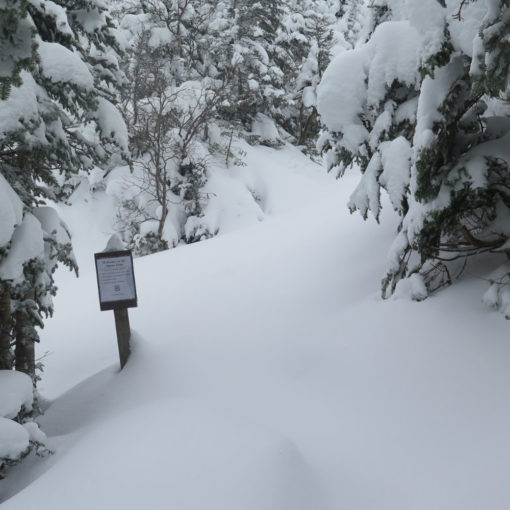OK, so a joke with some of my dearest friends is that my living room looks a bit like an AMC hut. I accumulate gear. It wasn’t enough that I looked around online for a water filter: I had to get the various market leaders and test them out against each other. Oddly, though, I don’t seem to do that with hats, gloves, and mittens. Usually standing in front of the display at the store, trying them out, seems to do just fine. And yet, why this pair over that other one?
In the past couple months, a couple pair have stood out. So much so that I want to tell you about them, because when you have warm hands, it makes so much of a difference. In terms of little things you can do to improve your life, this seems one of those places where small improvements bring outsized returns.
To start with… I’m giving a review based on my direct experiences. If I’m talking about gear on my blog, it’s because I own it, bought it with my own money, and have gotten some miles on the trail using it. (And yes, this means that I have a pile of gear that collects dust because I found something that worked better.) I’m not basing anything on reviews I’ve read or heard elsewhere, nor have I gotten any kind of consideration from a manufacturer or other outside interest. No-one has given me gear nor money for my opinion.
Next, and this should be obvious. I’m writing based on my experience. If you tend to run hotter or colder, or maybe you’ve got Raynaud’s Syndrome or something, adjust accordingly. Also, sometimes it takes a bit of time for me to get comfortable with something to the point where I’m writing about it. Occasionally this means things are discontinued — my OR Sensor Mitts (that I wear with OR Revel Shells) are one such example. I’m going to skip writing about those, focusing instead on the shells I wear them with.
My current mitten ensemble is at this end of a line that started out years ago with a pair of EMS gauntlet-length gloves insulated with Polartec. They’re still in the quiver for when I’m doing stuff that needs dexterity, and paired with lightweight liners, they’re very warm. Back before they gave up the ghost, I used Mountain Hardwear fleece liners that were paper thin, yet were quite warm. Then I got a pair of The North Face Himalayan Mitts, insulated with down and Primaloft. When I was skiing crazy amounts at Sunday River, Cannon, and even Mont Tremblant, they did yeoman’s duty for years. Around that same time, a friend gifted me a pair of Black Diamond Windstopper fleece gloves that, while they’re somewhat beat up, are still pulling like a truck — I wore them on the Kinsmans when I was wrapping up my first NH 48. Then, while perusing the racks more recently, my current new hotness caught my eye. The side message in this is that a good pair of mitts will do two things beyond keeping you warm: you’ll get a dose of sticker shock, but taken care of, you’ll get a lot of miles out of them. As in all things, you get what you pay for.
On Mittens v. Gloves: I’m a big fan of both. Awhile back, I’d have been entirely a fan of gloves, but then, after getting those TNF mitts, it made as much sense to give up the dexterity (that you don’t have with insulated winter gloves anyway) in favor of a little extra warmth. Honestly, I’m agnostic, choosing what’s best for the situation. But usually when the mercury drops, I’ll grab mittens and be as happy as can be.
Outdoor Research Revel Shell Mitts
First ones I’m going to talk about are the Outdoor Research Revel Shell Mitts. I have them coupled with their fleece Sensor Mitts, but any mid-weight fleece glove or mitten will probably be an acceptable substitute. I got them both in the middle of last spring, when conditions were so variable. And in my opinion, that’s where these really shine: in the meaty bit of the shoulder seasons, when you hit the trailhead in cold temperatures, get to the summit in much milder weather, and on the way down, the mercury starts to drop again.
The shells weigh about 100 grams. For comparison, a can of your favorite soft drink weighs about 350 grams. Right now, OR is making them out of Pertex, which is a waterproof, breathable fabric. I have a couple of their Pertex/fleece hoodies, and I think Pertex compares well to Gore-Tex.
One of the things I particularly like about the Revel Shells is that on their own, they can do so much to make my hands warmer. Days when the weather isn’t all that cold, but the wind has some tooth to it. They’re completely uninsulated, so think of when you just need something light to shield your hands, and make a little micro climate. The added bonus is that being a thin shell, using my camera is a little easier, a little more dexterous. It’s still gimpy, but very doable. And certainly better than if my hands were cold.
On the back of the fingers is a small loop that can be used for hanging, and on the cuffs is a bigger loop that you can’t miss with a carabiner, even in a stiff wind. At the wrists are cord loops that you put on and snug up — if you have to take off your mitts, they can just dangle, safe from being lost. And there’s some reflective piping on the back of the fingers, so if you do happen to drop them at night, you have a chance of finding them. They’re nice details. The palms have a textured synthetic material that covers the whole inside from fingertips to the wrist. And you can snug them up with a web strap at the wrist and an adjustable elastic at the end of the gauntlet.
Joining the shells with fleece mittens for full the effect does me fine into cold weather. I’m talking about those days after Thanksgiving, when we’re all breaking out the Microspikes, and maybe an “early” storm has dumped a few inches on Mt Washington. In my experience, if I’m breaking out the snowshoes, these and fleece liners might do, but I’ll probably wish I had my heavier mitts instead.
The shell’s gauntlet comes down well past my wristwatch, almost halfway up my arm. It blouses over the end of my sleeve very well. If I snug up the elastic, wind and snow have no chance of getting inside, and if I snug up the strap on the back, they don’t slide around. I’ve been very happy with their performance where temperatures are in the 20s and the wind is picking up. In arctic conditions on the top of the northern Pressies you’ll want something more robust, but if you’re moving along in the trees on those days, I think most people will find these work well. And even in the coldest of environments, the shell/liner combo occupies a spot in my pack for backup.
Outdoor Research Alti Mitts
The Alti Mitts are a substantial step up in bulk, weight, and warmth. On the hang-tag, OR had something about them being suitable for expeditions. Whether or not one is traversing a glacier in Nepal, they’re very nice, and in the shop, it wasn’t hard to understand why they’re so expensive. They’re almost exactly twice the weight of my Revel Shells and Sensor Mitts. In contrast to the Himalayan Mitts, of which these are a direct replacement, the insulation is entirely synthetic — Primaloft Gold and Polartec fleece. Put them on, and in moments, your hands warm up.
The Alti Mitts assembled are about 340 grams for the pair in size medium. The liners are about 115 grams, and the shells are 225 grams. Put in perspective, each component of my Alti Mitts is about twice the weight of the same component in my Revel Shell/Sensor combo. And as a side note, they’re 100 grams heavier than my North Face Himalayan Mitts. This is serious stuff.
Feeling the liner, there’s a noticeable difference in loft between the palm side and the back of the hand. While both have a robust amount of insulation, you can definitely feel there’s less on the palm, although it’s still quite well insulated. There’s a little bit of leather across the ends of the fingers and thumb, but otherwise, the mitt is nylon. At the back of the wrist is a velcro strap, and the gauntlet goes a small bit past my wristwatch — about half as much as the gauntlets on the Revel Shells. There’s velcro on both sides of the gauntlet end, because they’re meant to attach to the liners when paired up. Inside, there’s a small pocket into which you can stuff a heat pack, and that’ll sit on the back of your hand if you do so.
Unfortunately, while the liners velcro very firmly into the shells, if you take them out to wear the shells on their own, the liners need to go into a pocket or something — there’s no hanging loop, no connecting clip, nothing. Given that the liners and shells are insulated similarly, though, you’d probably wear the liners and hang the shells from your pack… unless you had to pound tent stakes or something where you’d want the durability of that leather palm. Thinking about it, I might at some point fix this by sewing on a small loop of p-cord or something. (Outdoor Research, are you seeing this?)
The Alti Mitt shells, unlike the Revel Shells, are made of insulated Gore-Tex. Compared to their liners, the loft is maybe half as much (or so) but still feels substantial. On a milder winter day, you could make a very versatile system with a thin liner glove, and have all kinds of options. The leather on the palm and thumb covers the whole inside of the hand, and goes up the sides, too. There’s a cord loop on the back of the index finger, like the Revel Shells, but no reflective material. The gauntlets go quite a bit further, very certainly past halfway up my arm. And they too have the gigantic carabiner loop and cords so they can tie to my wrists.
Now, a brief sidebar: I wish I never had to think of things like this, but I know if I fail to bring it up, someone’s going to make a grave error in judgement. Yes, these gloves have leather palms. Yes, the rest of the glove is synthetic. Yes, if you tend a campfire with these, it’s highly likely that you’re going to get much warmer hands than you bargained for. Don’t do it. Getting off the mountain with second and third degree burns on your hands because you set your gloves on fire is going to complicate your outing far beyond the pale. If your plans include tending any kind of heat source, including a camp stove, seriously consider bringing appropriate protective clothing. Don’t do anything that you’ll have to explain to the paramedics. Certainly nothing that might include “well, it seemed a good idea at the time.”
Paired up, they’re toasty. I wore them on Mt Washington, and then again on Mt Adams. They didn’t fail to please for even one moment. I think they were warm enough that it gave me the latitude to go lighter in other layers — a windbreaker instead of a heavier top layer above tree line on Washington, for example, and that made moving around feel more efficient. Thinking back to when I was skiing somewhere exposed to a bitter wind, these would have done me very well, especially all those times where I had a chilly lift-ride to sit through. And at the end of the day, taking them apart means they can hang to dry far quicker.
I might at some point get another thin pair of glove liners, for those times when I need real manual dexterity. Even as bulky as they are, I didn’t have much of an issue using my camera. OK, more so than with my other mitten ensemble, they’re gimpy, and I won’t even pretend to be able to tie my boots with them on or eat with chopsticks, but it’s not like they have to come off in order to do every tiny thing. It’s not fun, but you can fasten your pack’s buckles with them on well enough, and if you’ve got good sized zipper pulls, adjusting your zips is not all that difficult.
Conclusion
At least so far, Outdoor Research thankfully isn’t one of those companies that needs to have a horse running in every single race. As a result of their narrower range of offerings, when they take on a segment of the market, they show up bringing their A game. And these mittens are no exception. Out of the gate, they did me well, and I expect that to continue for the foreseeable future.
Expect that a pair of Revel Shell Mitts are going to run you about $70, while the Alti Mitts will be around $200. “Winter hiking gear is inexpensive” said no-one ever. Shop around for the best deal. No need to put yourself in the poor house just to feed your hiking obsession.
As always, stay safe out there.
If you enjoy reading these posts, please subscribe — stay in the loop! Your email will only be used to alert you of new posts — typically 1-2 times per week. I will not use or share your email for any other purpose without your express permission.





4 thoughts on “Gear Review: Outdoor Research mittens”
Big fan of Outdoor Research products. I have a pair of OR ski gloves with velcro-in liners and they’re just awesome. And the liners are machine washable. Pro tip: turn the liners inside out before washing and they won’t velcro themselves onto your socks in the dryer.
That’s a neat tip. I also keep a bevy of lingerie bags for isolating things, including stuff with velcro. So here’s another pro tip: pair up your socks in said bags, and you’ll never chase after missing socks again. Make it easier by keeping the empty bags near the laundry hamper.
Fan of the Alti mitts, in their 3rd winter WMNF season with me, and going strong. Believe it or not, I don’t even bother taking the Alti overmitts shells anymore, just the “liners” which themselves are very substantial. I’ve only used the overmitt a few times so I don’t even bother carrying them most of the time. My usual winter system is a liner mitt within the Alti liner — in my case, the OR Backstop Sensor mitt (which, annoyingly, has been discontinued.) Any other thin-ish mitten or glove liner would do, but typically on an ascent I’m generating alot of heat and just using the Backstop liner, which is also windproof and sheds snow reasonably well (is not waterproof though). When my hands start getting chilled, I just put the Alti liner over it, and I’m good. The Alti liners are also waterproof and do well when wet outside and/or inside from perspiration. As for easy access, I have a small piece of shock cord on the front of a shoulder strap that I just pull the Alti’s through vertically (open ends of the mitts pointing to the ground, to avoid snow falling in.)